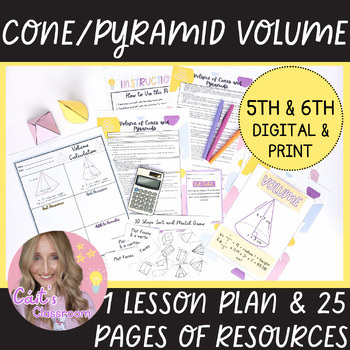Cone/Pyramid Volume Math Lesson Plan │Worksheets & Volume Game│5th/6th Grade
- Zip
Also included in
- Looking for an engaging math unit on measuring the volume of 3D shapes that your fifth/sixth graders will love? Want step-by-step lesson plans, printable/digital games and activities and hands-on, project based learning and rubrics? Then this resource is for YOU!This unit is aligned with both CCSSMPrice $19.60Original Price $27.40Save $7.80
Description
Searching for an engaging lesson for fifth/sixth grade on cone/pyramid volume using the metric system? Want it to include worksheets, an interactive game and guided practice? Then this resource is for ✨️YOU!✨️
Take the stress out of creating complete lesson plans and resources! This lesson includes a 3D shape matching game, hands-on main activity on calculating and measuring volume, a digital presentation and guided practice to consolidate key concepts.
This resource is also aligned with both CCSSM and the Irish Primary Mathematics Curriculum (2023) for seamless integration into planning documents. ✏️
Say goodbye to weekends planning on your laptop and hello to an engaged classroom – grab your copy TODAY!
⭐️Benefits⭐️
✅️ Reduces planning demands on teachers, saving valuable time and effort while being well-designed and aligned with curriculum standards.
✅️ Offers a complete, print-and-go resource with step-by-step instructions, ideal for newly qualified teachers who want support teaching math to the senior grades.
✅️ Enhances conceptual understanding and procedural fluency in calculating and measuring the volume of cones and square based pyramids.
⭐️ In Depth Description ⭐️
This 45-minute lesson plan includes:
✅️1 3D shape sort and match game - Engages students in interactive learning, reinforcing their understanding of cone and pyramid volume concepts through hands-on exploration.
✅️2 volume formula posters - Provides visual aids to support students in understanding and applying the volume formulas for cones and square-based pyramids.
✅️1 digital presentation that breaks down each formula step by step - Guides students through the process of calculating volume, offering clear explanations and visuals to support their learning and comprehension.
✅️4 3D shape nets (colour and black & white) - Allows students to construct physical models of cones and square-based pyramids, providing tangible representations to deepen their understanding of volume concepts.
✅️2 guided practice worksheets (colour and black & white) - Offers structured practice exercises for students to apply volume formulas and physically measure the volume of cones and pyramids.
✅️3 learning objectives: Clearly defines lesson outcomes, guiding both teachers and students in their learning goals.
✅️Differentiation strategies: Accommodates diverse learning needs, ensuring all students can access and succeed in the lesson.
✅️Assessment strategies: Provides practical guidance on assessing student understanding throughout the lesson.
✅️Key vocabulary and definitions: Equips students with essential language for effective communication about cone and pyramid volume.
✅️Exit tickets (colour and black & white): Quickly gauges student understanding at the end of the lesson, providing valuable feedback for future instruction.
✅️Fully aligned with the new Irish Primary Mathematics Curriculum (2023), specifically the element of understanding and connecting and the competencies of being mathematical, being an active learner and being an effective communicator.
✅️Common Core aligned - CCSS.5.MD.C.3, CCSS.5.MD.C.4, CCSS.MP.5, CSS.MP.6:
⭐️ Other Uses ⭐️
- Math Centers: Set up the 3D shape sort and match game, volume formula posters, and guided practice worksheets in as station teaching activities. Students can rotate through the centers independently or in small groups, providing opportunities for hands-on practice and reinforcement of cone and pyramid volume concepts.
- Interactive Review: Assign the digital presentation as an interactive review activity. Provide students access to the presentation online and encourage them to work through the step-by-step breakdown of volume formulas, reinforcing their understanding in a self-directed manner
- Extension Activities: Use the 3D shape nets as the starting point for extension activities for advanced students. They can explore additional 3D shape nets beyond cones and pyramids, or create their own volume formula posters for more complex geometric figures. This encourages creativity and deeper exploration of mathematical concepts.
➡️ Don't let this opportunity slip away! Elevate your teaching experience and engage your students - secure your complete lesson plan and resources TODAY! ⬅️
Click here to join the Cáit's Classroom mailing list for valuable tips, tricks, and special offers designed to support newly qualified teachers in effectively teaching maths to 3rd-6th class students.
⭐ Related Products ⭐
⭐ Cube/Cuboid Volume Lesson Plan│Worksheets, Digital/Hands-On Activities │5th/6th
⭐ Cube/Cuboid Volume Lesson Plan│Worksheets, Games, Problem Solving│5th/6th Grade
⭐ Volume of Cylinders Lesson Plan │Project Brief & Assessment Rubric│5th/6th Grade
⭐ Additive Volume Lesson Plan │Worksheets, Games, Guided Practice│5th/6th Grade






